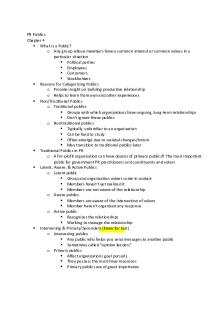Public Relations Theories-ppt PDF

| Title | Public Relations Theories-ppt |
|---|---|
| Author | Kaylee Ebanks |
| Course | Public Relations |
| Institution | Hunter College CUNY |
| Pages | 26 |
| File Size | 449.5 KB |
| File Type | |
| Total Downloads | 78 |
| Total Views | 174 |
Summary
Public relations theories...
Description
What%is%a%Theory?% A"theory"can"be"defined"as"a"prediction"of" how"events"and"actions"are"related.""" Communication"theories"detail"the"reactions" that"follow"from"actions,"allowing"those"who" understand"them"to"explain,"and"even" predict,"the"consequences"of"certain"patterns" of"communicating."""
What%is%a%Theory?% Theories"that"predict"how"audiences"will" react"in"certain"situation"or"to"certain" messages"are"especially"helpful"to"public" relations"practitioners.""" Achieving"persuasion"and"information" objectives"with"every"message" communicated"is"central"to"successful"pubic" relations"practice."""
What%is%a%Theory?% Theories"help"guide"message"design"so" whatever"is"being"communicated"has"the" best"chance"of"achieving"the"goals"outlined"in" a"public"relations"program.""" To"achieve"success,"understanding"of"the"
theories"that"underpin"pubic"relations"is" extremely"important."
While"there"are"many"theories"that"can"be"
applied"to"public"relations,"those"that"are" perhaps"most"useful"fall"into"one"of"three" categories:"" relationship"theories;"" cognition"and"behavior"theories;"and" "communication"theories.""
Relationship%theories:%% Explain"how"entities"interact."" They"not"only"outline"how"public"relations"fits"into"
organizational"structures,"but"how"stakeholders"fit" into"the"mix"of"publics"upon"whom"practitioners" focus."
Theories%of%cognition%and%behavior:% Help"explain"how"audiences"assimilate"and"then"
act"upon"information"received.""" Knowledge"of"cognition"and"behavior"theories" enable"practitioners"to"anticipate"how"an" audience"will"respond"to"various"messages." This"knowledge"enables"them"to"nudge"publics"to" perform"in"a"manner"that"is"most"positive"toward" the"client.""
Theories%of%mass%communication:% %Outline"the"reasons"the"public"responds"to"
messages,"and"how"interpretation"of"information" received"can"influence"perceptions.""
Theories"of"Relationships" systems"theory" situational"theory;"and" "conflict"resolution.""
Systems"Theory" Argues"that"the"attitudes"and"actions"of"an"
organization"or"public"contribute"to"a"causeL effect"chain"reaction"within"their"environment.""" − Systems"theory"is"useful"to"public"relations" because"it"helps"the"practitioner"manage"the" organization’s"relationships.""" − Emphasizes"interdependence"between"an" organization"and"its"internal"and"external" environments."
Systems"Theory" Close"systems:"" − focus"on"the"history"of"the"organization"and"
make"decisions"based"on"past"experiences.""" Open"systems:" − "focus"on"input"from"external"publics"and" the"organization’s"external"environment."
Situational"Theory"
Based"on"the"premise"that"people"will"act"on"an" issue"or"situation"when"they"believe"it"affects"them" personally"and"their"actions"can"make"a"difference."" There"are"three"variables:" Problem%recognition%
− People"must"be"able"to"see"the"potential"of"an"issue" to"affect"them"personally." Constraint%recognition% −
People"must"see"that"they"can"do"something"about"the"issue."
Situational"Theory"
Based"on"the"premise"that"people"will"act"on"an" issue"or"situation"when"they"believe"it"affects"them" personally"and"their"actions"can"make"a"difference."" There"are"three"variables:" Problem%recognition%
− People"must"be"able"to"see"the"potential"of"an"issue" to"affect"them"personally." Constraint%recognition% −
People"must"see"that"they"can"do"something"about"the"issue."
Situational"Theory" Level%of%involvement% − %People"must"care"about"resolving"the"issue."
Conflict%Resolution%Approaches% Conflicts"involve"an"individual"or"group"actively" opposing"another"because"of"difference"in"values" and"goals."""
There%are%four%ways%conflicts%can%be%resolved" Separate"the"people"from"the"problem." Focus"on"interests,"not"positions." Invent"options"for"mutual"gain."" Insist"on"objective"criteria"
Cognition%and%Behavior% Cognitive"theories"deal"with"thought"
processes"" Behavioral"theories"deal"with"action."" "Public"relations"practitioners"find"it"useful" to"think"about"effects—how"the"client’s" behavior"affects"others.""Words"and"actions" are"given"personalized"meanings"by" others,"and"sometimes"that’s"not"the" intended"meaning.""
Cognition%and%Behavior%
The%social%exchange%theory:%% − argues"that"people"generally"act"in"ways"that"they" assume"will"reduce"costs"and"increase"rewards."" − "PR"practitioners"try"to"make"decisions"based"on" the"assertion"that"people"will"factor"in"the" consequences"of"their"behavior"before"they"act.""" − Practitioners"must"try"to"keep"costs"low"and" rewards"high"in"everything"from"survey"responses" to"product"recalls.""
Cognition%and%Behavior%
When"the"situation"is"complex,"the" practitioner"must"employ"a"payLoff"matrix" to"evaluate"all"possible"decisions"with"their" accompanying"costs"and"rewards."
Cognition%and%Behavior%
Social%learning%theory% − argues"that"personal"example"and"mass" media"can"be"important"for"acquiring"new" behaviors.""New"behavior"is"likely"to"occur" when"it"is"seen"as"potentially"rewarding.""
Theories%of%Mass%Communication% Use"and"Gratification"Theory" Agenda"Setting"Theory"
Theories%of%Mass%Communication% Use"and"Gratification"Theory" Argues"that"people"are"active"users"of" the"media"and"choose"how"and"when"to" use"the"media"based"on"its"gratification" for"them.""" Public"relations"practitioners"should" research"why"particular"publics"use"the" media."""
Agenda"Setting"Theory" Based"on"the"assumption"that"although" media"can’t"tell"people"what"opinion"to"hold" about"an"issue,"it"has"influence"on"what"issues" people"think"about.""" The"agenda"setting"theory"proposes"that" media"has"the"potential"to"build"issue"or" product"awareness"and"increase"the"salience" of"an"issue."
Excellence"theory" Model"1"–"Press"Agentry"" - This"model"is"used"more"often"than"we"would" prefer.""""Grunig"and"Hunt"in"1984"revealed"that" 15%"of"PR"practitioners"used"this"approach.""Later" research"showed"that"most"PR"practitioners"use" this"strategy." Model"2"–"Public"Information" – Truth"in"this"model"is"essential,"as"the"practitioner" is"transferring"accurate"information"to"publics."" This"approach"is"used"especially"by"government" agencies.""It#is#a#one*way#flow#of#information."
Excellence"theory" Model"3"–"TwoLWay"Asymmetric"–"Also"called"
the"Scientific"Persuasion"Model" – In"this"model"the"practitioner"uses"social"science" theory"and"research,"such"as"surveys"and"polls,"to" help"persuade"publics"to"accept"the"organization’s" position.""There"is"feedback,"but"it"is"used"in"the" interest"of"the"company" – Nexflix"changing"policies"about"renting"DVDs"and" streaming"without"feedback"from"customers,"and" the"resulting"crisis"is"an"example."
Excellence"theory" Model"4"–"TwoLWay"Symmetric"–"also"called"
the"mutual"understanding"model" - In"this"model"the"practitioner"tries"to"achieve" dialogue,"not"monologue." - Management"or"the"publics"may"make"changes"in" behavior"as"a"result"of"the"communication" program" - Research"and"social"science"theory"are"used"not"to" persuade"but"to"communicate." - Effective"public"relations"programs"based"on"this" model"are"called"“excellent”"programs."
Excellence"theory" Public"relations"programs"are"more"likely"to"be"excellent"
when"public"relations"is"an"integral"part"of"an" organization’s"strategic"management"process,"and"when" managed"strategically." Public"relations"programs"are"managed"strategically"when" they"identify"stakeholders"and"resolves"issues"through" symmetrical"communications"programs"early"in"the" development"of"issues."
Excellence%theory%
Excellent"public"relations"programs"have"the" characteristics"below."
– Public Relations is part of top management in the organization – Programs are designed to build relationships with all key stakeholders – Public relations, through research, identifies who the organization’s key stakeholders are and ranks them in order of importance
– An ongoing public relations plan is developed for each public/stakeholder o Strategies and tactics are developed and implemented, for example, to lessen the likelihood of crises (treating a sniffle before it becomes a flu)...
Similar Free PDFs

Public relations
- 60 Pages

Public relations
- 15 Pages

Public Relations
- 24 Pages

Kampanye Public Relations
- 154 Pages

Chapter 4 - Public Relations
- 3 Pages

Sports public relations
- 3 Pages

AMB263 Public Relations A1
- 4 Pages

Public relations theory
- 11 Pages

Professional Public Relations
- 199 Pages

Mastering Public Relations
- 188 Pages

Public Relations - Syllabus
- 5 Pages

Public Relations Assignment
- 3 Pages

DIGITAL PUBLIC RELATIONS
- 10 Pages

Public Relations Theories-ppt
- 26 Pages

Public Relations week 1 notes
- 3 Pages
Popular Institutions
- Tinajero National High School - Annex
- Politeknik Caltex Riau
- Yokohama City University
- SGT University
- University of Al-Qadisiyah
- Divine Word College of Vigan
- Techniek College Rotterdam
- Universidade de Santiago
- Universiti Teknologi MARA Cawangan Johor Kampus Pasir Gudang
- Poltekkes Kemenkes Yogyakarta
- Baguio City National High School
- Colegio san marcos
- preparatoria uno
- Centro de Bachillerato Tecnológico Industrial y de Servicios No. 107
- Dalian Maritime University
- Quang Trung Secondary School
- Colegio Tecnológico en Informática
- Corporación Regional de Educación Superior
- Grupo CEDVA
- Dar Al Uloom University
- Centro de Estudios Preuniversitarios de la Universidad Nacional de Ingeniería
- 上智大学
- Aakash International School, Nuna Majara
- San Felipe Neri Catholic School
- Kang Chiao International School - New Taipei City
- Misamis Occidental National High School
- Institución Educativa Escuela Normal Juan Ladrilleros
- Kolehiyo ng Pantukan
- Batanes State College
- Instituto Continental
- Sekolah Menengah Kejuruan Kesehatan Kaltara (Tarakan)
- Colegio de La Inmaculada Concepcion - Cebu
